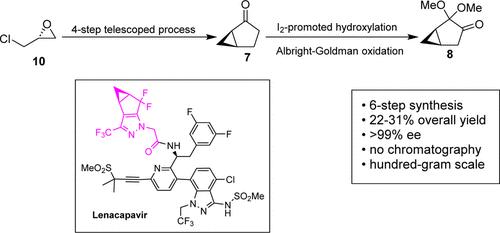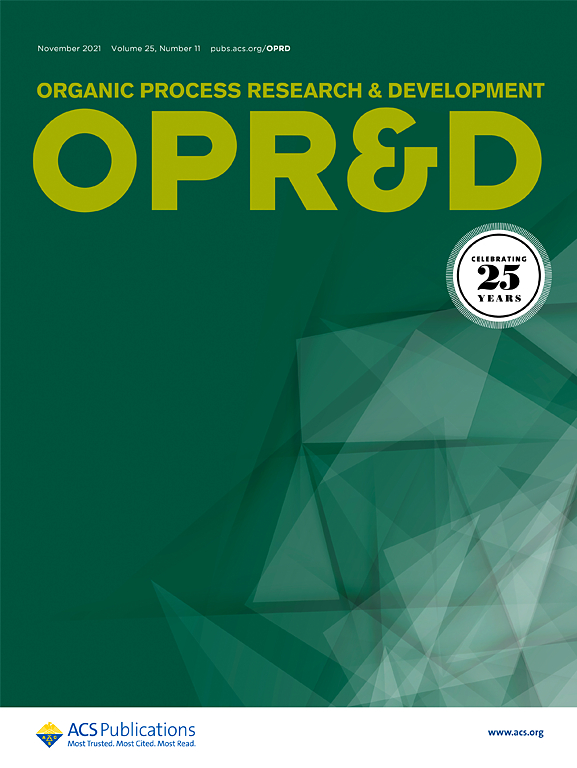Development of a Scalable Synthetic Route to (1R,5R)-2,2-Dimethoxybicyclo[3.1.0]hexan-3-one: An Important Intermediate in the Synthesis of Lenacapavir
IF 3.1
3区 化学
Q2 CHEMISTRY, APPLIED
引用次数: 0
Abstract
(1R,5R)-2,2-Dimethoxybicyclo[3.1.0]hexan-3-one is used in the asymmetric synthesis of lenacapavir. Herein, we report an enantioselective synthesis of this important chiral intermediate from the inexpensive commodity (R)-epichlorohydrin. This synthetic method comprises 6 steps, including a 4-step telescoped bicyclic ketone synthesis, I2-promoted hydroxylation, and an Albright–Goldman oxidation. This sequence affords (1R,5R)-2,2-dimethoxybicyclo[3.1.0]hexan-3-one in an overall 25% isolated yield as an enantiomerically pure compound. The entire process has been successfully demonstrated on a hundred-gram scale.

Lenacapavir合成重要中间体(1R,5R)-2,2-二甲氧基双环[3.1.0]己烷-3- 1的可扩展合成路线的建立
(1R,5R)-2,2-二甲氧基双环[3.1.0]己烷-3-酮用于lenacapavir的不对称合成。在此,我们报道了从廉价商品(R)-环氧氯丙烷中对映选择性合成这种重要的手性中间体。该合成方法包括6个步骤,包括4步缩合双环酮合成、i2促进羟基化和Albright-Goldman氧化。该序列提供(1R,5R)-2,2-二甲氧基双环[3.1.0]己烷-3- 1,分离产率为25%,是对映体纯化合物。整个过程已经成功地在百克尺度上进行了演示。
本文章由计算机程序翻译,如有差异,请以英文原文为准。
求助全文
约1分钟内获得全文
求助全文
来源期刊
CiteScore
6.90
自引率
14.70%
发文量
251
审稿时长
2 months
期刊介绍:
The journal Organic Process Research & Development serves as a communication tool between industrial chemists and chemists working in universities and research institutes. As such, it reports original work from the broad field of industrial process chemistry but also presents academic results that are relevant, or potentially relevant, to industrial applications. Process chemistry is the science that enables the safe, environmentally benign and ultimately economical manufacturing of organic compounds that are required in larger amounts to help address the needs of society. Consequently, the Journal encompasses every aspect of organic chemistry, including all aspects of catalysis, synthetic methodology development and synthetic strategy exploration, but also includes aspects from analytical and solid-state chemistry and chemical engineering, such as work-up tools,process safety, or flow-chemistry. The goal of development and optimization of chemical reactions and processes is their transfer to a larger scale; original work describing such studies and the actual implementation on scale is highly relevant to the journal. However, studies on new developments from either industry, research institutes or academia that have not yet been demonstrated on scale, but where an industrial utility can be expected and where the study has addressed important prerequisites for a scale-up and has given confidence into the reliability and practicality of the chemistry, also serve the mission of OPR&D as a communication tool between the different contributors to the field.

 求助内容:
求助内容: 应助结果提醒方式:
应助结果提醒方式:


